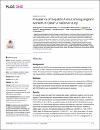Prevalence of hepatitis A virus among migrant workers in Qatar: A national study
| المؤلف | Younes, Nadin |
| المؤلف | Chemaitelly, Hiam |
| المؤلف | Nizamuddin, Parveen Banu |
| المؤلف | Al-Hamad, Tasneem |
| المؤلف | Abdallah, Marah |
| المؤلف | Yassine, Hadi M. |
| المؤلف | Abu-Raddad, Laith J. |
| المؤلف | Nasrallah, Gheyath K. |
| تاريخ الإتاحة | 2024-09-09T10:33:13Z |
| تاريخ النشر | 2024-07-01 |
| اسم المنشور | PLoS ONE |
| المعرّف | http://dx.doi.org/10.1371/journal.pone.0306753 |
| الاقتباس | Younes N, Chemaitelly H, Nizamuddin PB, Al-Hamad T, Abdallah M, Yassine HM, et al. (2024) Prevalence of hepatitis A virus among migrant workers in Qatar: A national study. PLoS ONE 19(7): e0306753. https://doi.org/10.1371/journal.pone.0306753 |
| الملخص | Background Hepatitis A virus (HAV) is the predominant cause of acute viral hepatitis worldwide; however, data on HAV antibody prevalence (seroprevalence) among migrant populations are limited. This study aimed to investigate HAV seroprevalence among Qatar’s migrant craft and manual workers (CMWs), constituting approximately 60% of the country’s population. Methods HAV antibody testing was conducted on stored serum specimens obtained from CMWs during a nationwide severe acute respiratory syndrome coronavirus 2 (SARS-CoV-2) population-based cross-sectional survey between July 26 and September 9, 2020. Associations with HAV infection were investigated through regression analyses. Results Of the 2,607 specimens with HAV antibody test results, 2,393 were positive, and 214 were negative. The estimated HAV seroprevalence among CMWs was 92.0% (95% CI: 90.9–93.1%). HAV seroprevalence was generally high but exhibited some variation, ranging from 70.9% (95% CI: 62.4–78.2%) among Sri Lankans to 99.8% (95% CI: 98.2–99.9%) among Pakistanis. The multivariable regression analysis identified age, nationality, and educational attainment as statistically significant factors associated with HAV infection. Relative to CMWs aged ≤29 years, the adjusted relative risk (ARR) was 1.06 (95% CI: 1.03–1.10) in CMWs aged 30–39 years and reached 1.15 (95% CI: 1.10–1.19) in those aged ≥50 years. In comparison to Indians, the ARR was lower among Sri Lankans, assessed at 0.81 (95% CI: 0.72–0.91), but higher among Nepalese at 1.07 (95% CI: 1.04–1.11), Bangladeshis at 1.10 (95% CI: 1.07–1.13), Pakistanis at 1.12 (95% CI: 1.09–1.15), and Egyptians at 1.15 (95% CI: 1.08–1.23). No evidence for differences was found by geographic location or occupation. Conclusions HAV seroprevalence among Qatar’s CMW population is very high, with over nine out of every ten individuals having been exposed to this infection, likely during childhood. |
| راعي المشروع | The authors express their gratitude for the support from the Biomedical Research Program and the Biostatistics, Epidemiology, and Biomathematics Research Core at Weill Cornell Medicine-Qatar. We also acknowledge the support from the Ministry of Public Health and Hamad Medical Corporation. This work received funding from the National Priorities Research Program (NPRP) through grant numbers 12S-0216-190094 (LJA), 13S-0128-200185 (GKN), GSRA8-L-1-0501-21022 (NY), and UREP30-041-3-014 (GKN) provided by the Qatar National Research Fund (a member of Qatar Foundation - https://www.qf.org.qa/research/qatar-national-research-fund). Additionally, Qatar University supported this research under the collaborative grant QUCG-BRC-23-24-170. The funders had no role in study design, data collection and analysis, decision to publish, or preparation of the manuscript. Statements made herein are solely the responsibility of the authors. |
| اللغة | en |
| الناشر | Public Library of Science |
| الموضوع | Hepatitis A virus Qatar Virus testing Vaccination and immunization Epidemiology Medical risk factors SARS CoV 2 |
| النوع | Article |
| رقم العدد | 7 JULY |
| رقم المجلد | 19 |
| ESSN | 1932-6203 |
الملفات في هذه التسجيلة
هذه التسجيلة تظهر في المجموعات التالية
-
أبحاث مركز البحوث الحيوية الطبية [764 items ]
-
العلوم الحيوية الطبية [763 items ]
-
الصحة العامة [462 items ]


